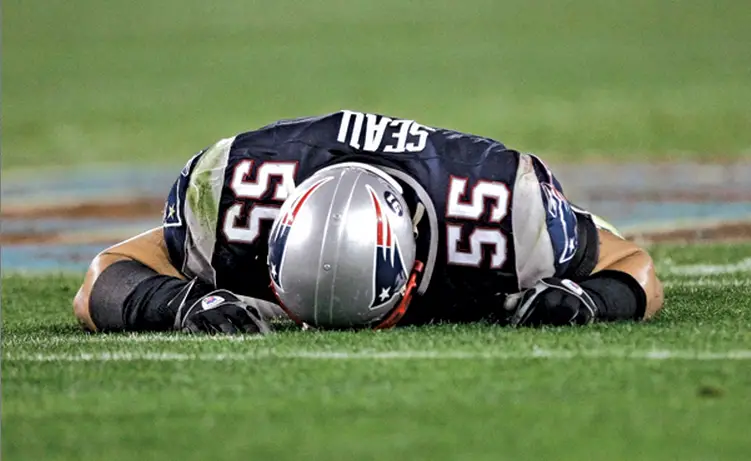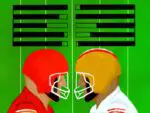Would you want to play a sport if it meant you’d lose your marbles by the age of fifty? I wouldn’t. Though I love football, it’s become clearer and clearer over the last several years that maybe football isn’t that cool. I mean, it is cool. Like, so cool. And fun. But, what other sport is buried in as much controversy as football?
There’s always something going on with Roger Goodell or the NCAA or coaches treating players like poop. Always. It seems like every time I watch ESPN it’s something new. And now, a New York Times investigation recently revealed that the NFL may have been trying to downplay the dangers of playing.
In a study held between 1996 and 2001, a record of 887 concussions was kept, with symptoms and recovery time for each case recorded, in an attempt to better understand brain injuries.
However, the NFL surreptitiously omitted 100 concussions, leaving many, including me, collectively lost in the shade the NFL is apparently casting over the country. Nearly 1,000 concussions over a five-year span? That’s insane!
“How can it be that dangerous? All the players are decked out in those super protective helmets and pads! It’s not like anyone is dying on the field, right? Sure, you might bang your head pretty hard or pull a hammy every now and then, but athletes in all sports run that risk,” is what I imagine a truly ignorant person would respond.
Yeah, I said it, an ignorant person. If you found yourself thinking that before you read it on here, I’m calling you ignorant. I’m only confident enough to say that because I just spent a good portion of my day researching this exact thing, and you’re about to get overloaded with facts supporting my claim.
The number of concussions in the NFL has been rising, more or less, every year. Recently, Roger Goodell finally acknowledged a link between playing football and chronic traumatic encephalopathy, or CTE, after numerous studies of deceased NFL players brains over the last decade or two basically confirmed this fact.
Depending on where you look, the aforementioned studies concluded that as many as 96 percent of deceased NFL players and 79 percent of deceased football players, in general, tested positive for CTE. It may have even contributed to Junior Seau’s suicide several years ago. This is not only alarming, but also scary. I’m trembling as I write this.
Now, I want you to think about another similarly dangerous sport: rugby. Thought about it? Okay, now I’m going to retract that statement and say that rugby is actually not a dangerous sport. At least, nowhere near as dangerous as football.
Football is to rugby as eating an entire raw pufferfish is to eating a California roll. Unless you choke on a splinter from your chopsticks, the probability of dying from your sushi is very slim. But, an uncooked pufferfish will for sure kill you.
I say this because, whereas F#$&ING 96 PERCENT of dead NFL players are reported to have CTE, in a 2013 BBC article, a neuropathologist with a great name, Dr. Willie Stewart, recorded, perhaps, the first ever confirmed case of CTE in a rugby player. As noted in the article, Stewart claims that “one or two” rugby players may develop CTE every year, and that it’s far more likely for American football players, who “suffer repeated head trauma and concussions,” to develop the condition. How can this be?
If you have eyes (which I have reason to believe you do), you know that rugby players wear significantly less padding than football players. Thinly padded chest/shoulder protection and a helmet that resembles, somewhat ironically, an early 1900s leather football helmet are allowed, but only a mouthguard is required. It’s understandable to assume that fewer pads equals more injuries—I too thought that until recently. An understandable thought, yes, but, ultimately, an incorrect one.
Think of it this way: You’re much more likely to go skydiving if you know for a fact that your parachute will deploy. You’re more likely to go 150 mph on a motorcycle if you’re wearing a helmet, a thick leather jacket and jeans, instead of a visor, Hawaiian shirt and shorts. You’re more likely to attempt that sick 720 tailgrab off the halfpipe if you’re wearing elbow pads, knee pads and a helmet.
The same can be said for football. With all the “protective” gear football players wear, they’re more likely to do things that put themselves at risk. Alternatively, if you are going down the halfpipe without pads and a helmet, you’re probably gonna opt for a much safer trick.
What I mean is that there’s a huge difference in the mentality between rugby and football players. By wearing less protective gear, rugby encourages players to play the game in a way that doesn’t put their well-being at risk.
In contrast, with all their pads, football players look indestructible to other players, leading players to go all out on every hit. Players also feel indestructible, making them okay with matching a tackler’s full-force hit with a full-force counter hit. They’re also much more likely to put themselves in harm’s way. The athlete’s psyche plays a huge roll in how they play their game.
Apart from the mental aspect, the tackling technique between the two sports differs greatly. In rugby, players are taught to tackle cheek-to-cheek, avoiding head-on-collisions, whereas football teaches across the bow, or shoulder-to-shoulder contact.
Players are taught to get their head across the body of the opposing player, which often leads the opposing player to lower his head in an attempt to get smaller and avoid a big hit. This lends itself to much more violent hitting in football and much more helmet-to-helmet contact throughout a game.
Someone who’s not wearing a helmet doesn’t want to slam their skull into another person’s skull, but someone wearing a helmet is far less concerned.
Similarly, football players are taught to hit high, in the chest and to avoid the legs, which leads to more targeting (helmet-to-helmet). So, it’s easy to see how wearing less gear results in safer play between the sports.
Targeting is unheard of in rugby. Since the beginning, rugby players have always tackled each other lower, relative to football players. High hits are a big party foul, drawing a penalty from the referee and a minimum 10-minute ejection. But this is all part of the culture surrounding the two sports, which encourages safety in rugby and violence in football.
If football really wants to become safer, it (like everything) starts with the children. From a kid’s first practice, football coaches consistently encourage big, hard hits. They wanna hear the pads “pop.”
Players are forced to participate in hitting drills, where, as is the case in “Oklahoma drills” and other kinds of hitting practice, players go head-to-head trying to knock the most shit out of the other player.
Essentially, coaches are asking their players to hurt each other. Helmets and shoulder pads won’t protect you from another fully padded person who’s trying to break every bone in your body. All of this for the coaches’ praise.
Do you see the problem here? Nothing like this really exists in rugby. Hard hits aren’t encouraged, they’re penalized. In fact, there’s an understanding between players: No one has anything to prove. Because of this, they aren’t trying to beat one another to a pulp. It tends to be more civil. Plus, after a game, all the players go out and get beers together!
I gotta give big shouts to Pete Carroll, Rocky Seto and the Seattle Seahawks, who are actually trying to change the violent culture around football. Since Carroll hired Seto to the Seahawks coaching staff in 2010, Seto has tried to rewire the defensive players to tackle like rugby players.
This means a more leverage-based, shoulder technique to tackling. Coincidentally—but maybe not so coincidentally—Seattle’s defense has been arguably the best in the NFL since Seto joined Carroll. You have to at least put them in the top three to five defenses, which says a lot in the ever-changing landscape of the NFL. If you’re one of those people that think part of the NFL intrigue is big hits, I gotta say that Seattle’s defense is just as fun to watch as any other defense. But, they’re much safer, which is a good thing.
So, the NFL ought to take a lesson from rugby. It’s going to look really, really bad for the NFL when more bodies of former players start piling up with brain injuries related to their playing days. Especially given that the NFL has been so reluctant up to this point to acknowledge a connection between football, concussions and CTE. It really makes them look crooked. Immoral, even.
















